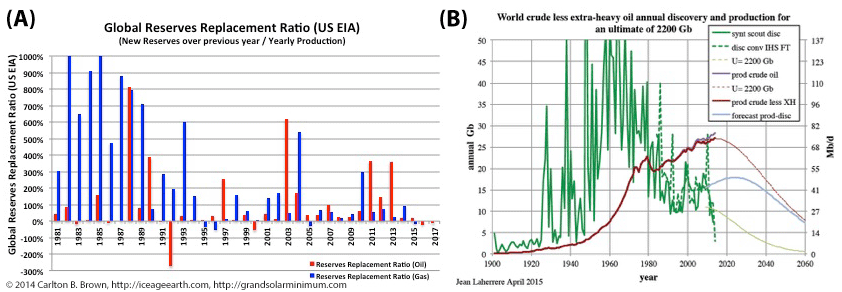If cumulative oil and gas reserve growth was as strong as we are told (see Figure B), then why has the world Reserves Replacement ratio (i.e., newly discovered reserves to annual production ratio), as depicted in Figure A above, stood at less than 100 percent in 28 of the last 37 years? Moreover, in at least three of nine years (2011-2013)[i] with a reserves replacement ratio greater than 100 percent, upward revisions to reserves involved unproven reserve volumes (new prediction methodologies), not new discoveries, and these revisions were not backdated to the original wildcat discoveries.[ii] The world is therefore consuming more oil than is being discovered each year. Figure B above highlights new oil discoveries (green) versus world annual oil production (brown). This figure highlights that peak oil discovery occurred in the 1960s.[iii]
Oil and Gas Discoveries Peaked in the Past
Conventional oil discoveries peaked in the 1960s, with new yearly additions on average below annual production since the early 1980s (Figure A).[iv] Peak natural gas discovery took place between 1960 and 1980,[v] and we will now spend the decades ahead building pipelines and piping those gas reserves to markets.
In the USA, the lower 48 states peaked in oil and gas discovery in the 1930s, with production peaking in the early 1970s. The North Sea reduced the time lag between peak discovery and peak production from 40 years (i.e., as in the USA) to 27 years, meaning industry has become more efficient at depleting reserves (i.e., over a shorter timeframe).[vi]
The largest fields and reservoirs within a given area are typically discovered early on,[vii],[viii] and tend to provide most of the reserve growth.[ix],[x] No super-giant reservoirs containing more than 5 billion barrels of oil have been discovered in decades.[xi],[xii]
It is also recognized by experts that the easiest measures to increase oil recovery from existing fields and reservoirs have already been taken, meaning that more costly, enhanced oil recovery methods will be needed to increase extractions in the future.[xiii] This enhanced extraction will require a higher oil price.
Such is the state of oil and gas discovery that only one in four oil and one in three increases in gas reserves are actually coming from new discoveries.[xiv],[xv] Companies today are simply not discovering as much in new reserves as they are producing in energy,[xvi] which means that they are depleting their reserves (see Figure 8.2.A). This is reflected in the world oil reserves-to-replacement ratio being less than 100 percent for 28 of the last 37 years.
A giant field today holds more than 500 million barrels of oil, which is the equivalent of five days of global production.[xvii] In recent years, the size of discoveries has been significantly smaller than 500 million barrels.[xviii] The downturn in market price for oil in recent years highlights the sensitivity of exploration to oil price, as new oil discoveries have not been at such low levels since the 1940s.[xix],[xx],[xxi]
New discoveries are increasingly being made at greater depths on land, in deeper sea water subject to larger storms (e.g. Hurricane Katrina), and at greater distances from markets.[xxii],[xxiii],[xxiv] These more difficult operating environments and the higher costs involved will need oil and gas prices to recover substantially to make exploration and extraction economically viable.[xxv]
Unconventional oil and gas resources are touted as the saviors of the oil and gas industry, and are already supplying a significant share of today’s production,[xxvi] along with offshore supplies.[xxvii] These unconventional reserves are largely concentrated in North America, Russia, the OPEC nations, China, and South America.[xxviii] Market commentators have cautioned against being overly optimistic about shale prospects, because of the early falloff in production rates at US shale wells. This has necessitated concentrating oil recovery efforts in “sweet spots” until oil prices recover.[xxix]
When I reflect on all of the above concerning oil and gas reserves, the obvious questions are, first, has peak-oil discovery and production come and gone?[xxx] Is the inclusion of unproven reserves in calculations of world oil supply hiding the fact that peak oil is in fact behind us? And are market commentators’ attempts to move the discussion from peak oil and peak discovery to peak demand and the adequacy of supply similarly designed to mask the fact that we are running out of proven reserves?[xxxi] The answer is yes on all counts.
[i] U.S. Energy Information Administration. “Technically Recoverable Shale Oil and Shale Gas Resources. An Assessment of 137 Shale Formations in 41 Countries Outside the United States.” June 2013. [See Table 2, page 3].
[ii] Data: Oil, gas, and coal data was obtained from the Energy Information Administration from their International Energy Statistics data portal. This graphic utilizes the following data files. Natural gas https://bit.ly/2LC6GBo, Crude Oil https://bit.ly/2IWeEaP, Coal data https://bit.ly/2L6pk3w. Standard fuel units of energy (barrels, cubic feet, and short tons) were converted to British thermal units (Btu) using conversion factors obtained from, https://www.eia.gov/energyexplained/index.php?page=about_btu.
[iii] Jean Laherrère, Public domain, via Wikimedia Commons. Image description: Global oil discovery and production, showing peak discovery in the 1960s. March 1, 2015. https://commons.wikimedia.org/wiki/File:World_crude_discovery_production_U-2200Gb_LaherrereMar2015.jpg.
[iv] Ian Chapman, 2014, “The end of Peak Oil? Why this topic is still relevant despite recent denials.” Energy Policy, 64. 93-101. http://insight.cumbria.ac.uk/id/eprint/1708/.
[v] Harry J. Longwell, “The future of the oil and gas industry: past approaches, new challenges.” World Energy Volume 5 No. 3 2002.
[vi] Jack Zagar, “The End of Cheap “Conventional” Oil. Independent Petroleum Engineering Consultant. http://www.hubbertpeak.com/Zagar/hawaii/.
[vii] David F. Morehouse, “The Intricate Puzzle of Oil and Gas “Reserves Growth”.” Energy Information Administration. Natural Gas Monthly July 1997. http://large.stanford.edu/courses/2014/ph240/liegl1/docs/morehouse.pdf.
[viii] Kjell Aleklett and Colin J. Campbell, “The peak and decline of world oil and gas production.” Minerals and Energy-Raw Materials Report 18.1 (2003): 5-20.
[ix] T.A. Cook, 2013, “Reserve growth of oil and gas fields—Investigations and applications.” U.S. Geological Survey Scientific Investigations Report 2013–5063, 29 p., http://pubs.usgs.gov/sir/2013/5063/.
[x] David F. Morehouse, “The Intricate Puzzle of Oil and Gas “Reserves Growth”.” Energy Information Administration. Natural Gas Monthly July 1997. http://large.stanford.edu/courses/2014/ph240/liegl1/docs/morehouse.pdf.
[xi] R.G. Miller, S.R. Sorrell, 2014, “The future of oil supply.” Philosophical Transactions of the Royal Society A 372: 20130179. http://dx.doi.org/10.1098/rsta.2013.0179.
[xii] Robert L. Hirsch et al., “Peaking of World Oil Production: Impacts, Mitigation, and Risk Management.” February 2005. https://www.netl.doe.gov/publications/others/pdf/Oil_Peaking_NETL.pdf.
[xiii] M. Höök, 2014, “Depletion rate analysis of fields and regions: a methodological foundation.” Fuel, Volume 121, 1 April 2014, 95–108. http://dx.doi.org/10.1016/j.fuel.2013.12.024.
[xiv] David F. Morehouse, “The Intricate Puzzle of Oil and Gas “Reserves Growth”.” Energy Information Administration. Natural Gas Monthly July 1997. http://large.stanford.edu/courses/2014/ph240/liegl1/docs/morehouse.pdf.
[xv] T.A. Cook, 2013, “Reserve growth of oil and gas fields—Investigations and applications.” U.S. Geological Survey Scientific Investigations Report 2013–5063, 29 p., http://pubs.usgs.gov/sir/2013/5063/.
[xvi] “Financial Review of the Global Oil and Natural Gas Industry 2015.” Markets and Financial Analysis Team. May 2016. https://www.eia.gov/finance/review/archive/pdf/financial_2015.pdf.
[xvii] Data, U.S. Energy Information Administration. International_data. https://bit.ly/2Rw5hiM. [Worldwide production was 97,977,000 barrels per day in 2017.]
[xviii] “All-time low for discovered resources in 2017: Around 7 billion barrels of oil equivalent was discovered.” December 21, 2017. https://www.rystadenergy.com/newsevents/news/press-releases/all-time-low-discovered-resources-2017/.
[xix] “All-time low for discovered resources in 2017: Around 7 billion barrels of oil equivalent was discovered.” December 21, 2017. https://www.rystadenergy.com/newsevents/news/press-releases/all-time-low-discovered-resources-2017/.
[xx] “Declining Reserve Replacement Ratios Deceiving In Resource Play Environment.” November. 28, 2017. View Issue. Maurice Smith. JWN Energy. Daily Oil Bulletin. https://www.sproule.com/application/files/2415/1188/2978/Sproule-Declining-Reserve-Replacement-Ratios-Nora-Stewart-Steve-Golko.pdf.
[xxi] Tom Whipple, “Peak Oil Review” Originally published by ASPO-US. December 26, 2017. https://www.resilience.org/stories/2017-12-26/peak-oil-review-dec-26-2017/
[xxii] Harry J. Longwell, “The future of the oil and gas industry: past approaches, new challenges.” World Energy Volume 5 No. 3 2002.
[xxiii] James A. Baker III Institute For Public Policy of Rice University In Conjunction With a Program Co-Sponsored By Petroleum Industry Research Foundation No. 14, November 2000 http://large.stanford.edu/publications/power/references/baker/reports/docs/study_14.pdf.
[xxiv] Jack Zagar, “The End of Cheap “Conventional” Oil.” Independent Petroleum Engineering Consultant. http://www.hubbertpeak.com/Zagar/hawaii/.
[xxv] Rystad Energy Annual Review of World Oil Recoverable Resources: Saudi Arabia adds oil resources ahead of IPO June 20, 2017. https://www.rystadenergy.com/newsevents/news/press-releases/2017-annual-oil-recoverable-resource-review/.
[xxvi] Wang Hongjun et al., “Assessment of global unconventional oil and gas resources.” Petroleum Exploration and Development. 2016, 43(6): 925–940.
[xxvii] Rystad Energy Annual Review of World Oil Recoverable Resources: Saudi Arabia adds oil resources ahead of IPO June 20, 2017. https://www.rystadenergy.com/newsevents/news/press-releases/2017-annual-oil-recoverable-resource-review/.
[xxviii] Wang Hongjun et al., “Assessment of global unconventional oil and gas resources.” Petroleum Exploration and Development 2016, 43(6): 925–940.
[xxix] Tom Whipple, “Peak Oil Review” Originally published by ASPO-US. December 26, 2017. https://www.resilience.org/stories/2017-12-26/peak-oil-review-dec-26-2017/.
[xxx] Kjell Aleklett et al., “The Peak of the Oil Age: Analyzing the World Oil Production Reference Scenario in World Energy Outlook 2008.” Energy Policy, Volume 38, no. 3, Elsevier Ltd, 2010, 1398–1414, doi:10.1016/j.enpol.2009.11.021.
[xxxi] Peak oil demand and long-run oil prices. https://www.bp.com/en/global/corporate/energy-economics/spencer-dale-group-chief-economist/peak-oil-demand-and-long-run-oil-prices.html.


